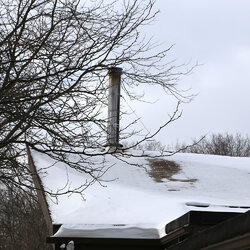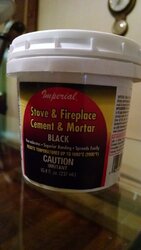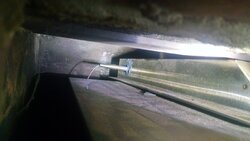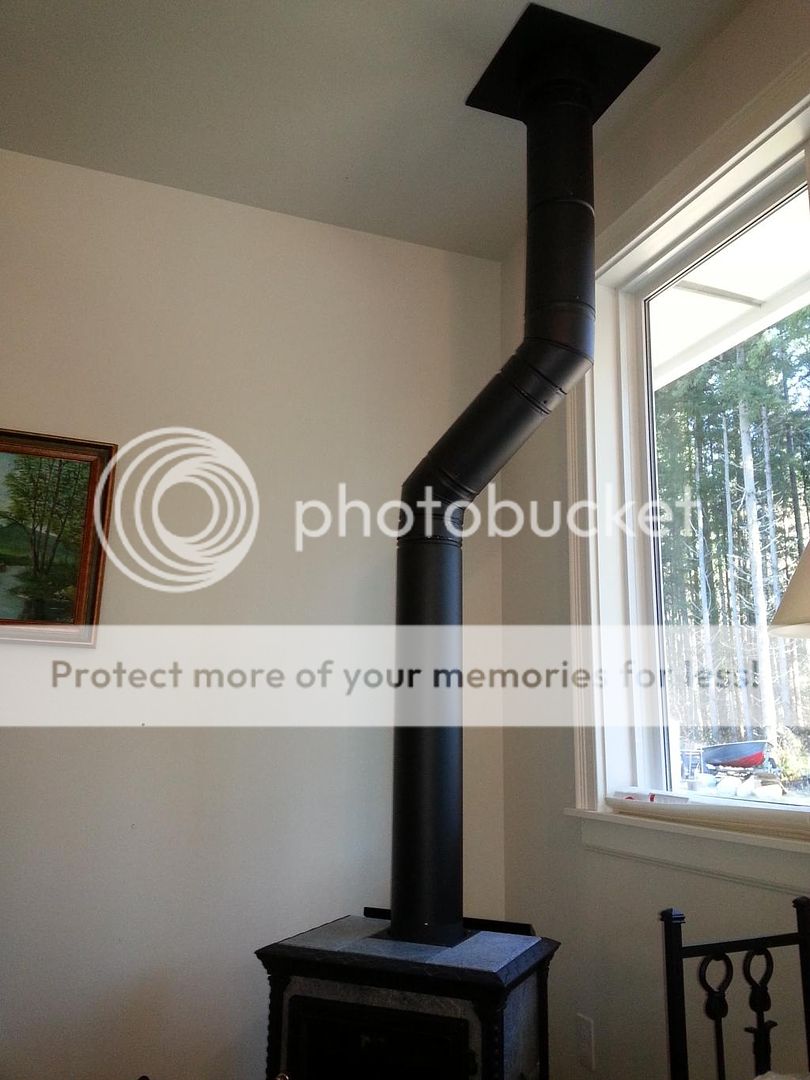Considering treating our double-walled interior stove pipe joints with high-temp furnace cement. I've heard that over a relatively short time period, this will cook and fail to seal. Possibly accelerated by pipe expansion/contraction. Experiences?
Furnace cement on pipe joints -- does it last?
- Thread starter Burnhaven
- Start date
-
Active since 1995, Hearth.com is THE place on the internet for free information and advice about wood stoves, pellet stoves and other energy saving equipment.
We strive to provide opinions, articles, discussions and history related to Hearth Products and in a more general sense, energy issues.
We promote the EFFICIENT, RESPONSIBLE, CLEAN and SAFE use of all fuels, whether renewable or fossil.
You are using an out of date browser. It may not display this or other websites correctly.
You should upgrade or use an alternative browser.
You should upgrade or use an alternative browser.
- Status
- Not open for further replies.
bendzuch
New Member
I used some on my old stove/pipe connection that was a bit loose and it did last 30 yrs. On my new one, I was concerned about the poor fit between the double wall stove pipe and the ceiling kit. I called ICC and he said small gaps are not an issue as the air will be far more likely to be going 'in' not 'out' due to draft. I used some thin stove gasket and wound it around the pipe between the joints to seal the joint and it worked much better than the cement I would have used. On my other double wall pipe connections, they are very tight and did not need anything.
All your pipe is backwards, crimp should be towards the stove. I just did an install with heat fab pipe & am very pleased with it. Little more pricey, & this is no place to save money!
bendzuch
New Member
this is double-walled pipe. From the selkirk installation manual:
"The orientation of all chimney connector components must
be with the crimped end (outer black pipe) pointing up,
towards the chimney"
"The orientation of all chimney connector components must
be with the crimped end (outer black pipe) pointing up,
towards the chimney"
I would change out the elbows for one-piece elbows made by the maker of the rest of the pipe. Those will fit the best and do away with the extra seams, except from one pipe to another. But there's some other issue causing smoke to come out the joints: Either a downdraft outside hitting the top of the stack, or a negative pressure issue. Did you try cracking a window (downwind) near the stove when smoke is coming out the joints. If it's a negative pressure issue, an OAK would fix it...
It has an OAK. The smoke from the joint was a one-time thing as I was learning how to properly load and burn with this stove. We do have CO detectors but I think I'll get a couple more to put along the walls. The concern is mainly that a dying fire slows the draw enough that if the furnace kicks in, it could pull CO into the room. So that's my reason for wanting to seal the joints even though many people here say " all pipes leak at the joints."
We can't turn off the furnace in our "granny quarters" wing of this house. ( https://www.hearth.com/talk/threads/wood-stove-in-two-suite-home.138030/#post-1853850 )
We can't turn off the furnace in our "granny quarters" wing of this house. ( https://www.hearth.com/talk/threads/wood-stove-in-two-suite-home.138030/#post-1853850 )
There is nothing wrong with your connector pipe. Furnace cement will not hold, many people think it does. I can tell you from experience, it will not. Its fine for the temperatures, the issue is that the pipe expands and contracts a great deal. The cement just cracks and falls out, even if it doesn't fall out its still not making a seal.
Cement is not the answer, something else is causing this issue. A properly functioning chimney will not smoke out of any joint, it will pull air in.
Cement is not the answer, something else is causing this issue. A properly functioning chimney will not smoke out of any joint, it will pull air in.
The pipe joints probably pull air in when the stove is operating. When it goes out, the air return to the furnace, I think, is pulling air out of the joints. This morning its doing that, but no odor, so last night's fire was a good one, burned down to ash. Problem is, carbon monoxide is odorless. I'm also wondering about how much expansion contraction goes on in the outside joints of double-walled pipe. A thermometer two feet below the ceiling never gets above 100F on this pipe.
Short of selling the stove and giving up on wood heat, I need to keep the joints sealed, block off the furnace return at least partially and get more CO detectors. ( there are two other air returns in the main section of the house that runs off the same furnace )
Short of selling the stove and giving up on wood heat, I need to keep the joints sealed, block off the furnace return at least partially and get more CO detectors. ( there are two other air returns in the main section of the house that runs off the same furnace )
I really think you are worrying too much. As an option your could buy better pipe. That Sekirk double wall pipe is entry level pipe and fits together very poorly. As your know.The pipe joints probably pull air in when the stove is operating. When it goes out, the air return to the furnace, I think, is pulling air out of the joints. This morning its doing that, but no odor, so last night's fire was a good one, burned down to ash. Problem is, carbon monoxide is odorless. I'm also wondering about how much expansion contraction goes on in the outside joints of double-walled pipe. A thermometer two feet below the ceiling never gets above 100F on this pipe.
Short of selling the stove and giving up on wood heat, I need to keep the joints sealed, block off the furnace return at least partially and get more CO detectors. ( there are two other air returns in the main section of the house that runs off the same furnace )
This pipe fits together very nicely and has tight joints.
http://www.duravent.com/Product.aspx?hProduct=11
Might have to consider better pipe, but as far as worrying about CO, read this:
http://www.abe.iastate.edu/extension-and-outreach/two-conditions-for-a-carbon-monoxide-hazard/
http://www.abe.iastate.edu/extension-and-outreach/two-conditions-for-a-carbon-monoxide-hazard/
IMHO the joints in the photos you posted look horrible to me. I would want everything fitting tight and exact. I spent hours with my installation getting the exact fit, it really is a PITA but necessary. The joint at the ceiling adapter looks wrong too. I don't own that kind of pipe so I can't comment on which way is up. It looks like you need another inch or two between the angles. It looks like the pipe has been pulled out of normal to make it reach to the stove.
I agree & disagree with webby. Pipe joint will work and last at least a few years if done right. I've done it but I will readily admit that it's not a good solution. The real answer is to put in better pipe and make sure it fits perfectly.
As an interim solution, I would block off your fresh air inlet when you are not using the stove and remove the ashes when your burn is done.
I agree & disagree with webby. Pipe joint will work and last at least a few years if done right. I've done it but I will readily admit that it's not a good solution. The real answer is to put in better pipe and make sure it fits perfectly.
As an interim solution, I would block off your fresh air inlet when you are not using the stove and remove the ashes when your burn is done.
The stove installer came back and adjusted the interior pipe joints. We did close off our air return and things are working better now. Soapstone stoves seem to require a new technique so I'm trying to figure that out. During the first part of a burn, the soapstone sucks up a lot of heat making it harder to get hot air up the chimney so it will draw.
That is very weird. Mine has an awesome draft and is super easy to start. I think you must have other problems somewhere. Soapstone/cast iron/steel should make no difference at all for getting decent draft and starting.Soapstone stoves seem to require a new technique so I'm trying to figure that out. During the first part of a burn, the soapstone sucks up a lot of heat making it harder to get hot air up the chimney so it will draw.
Good article on soapstone here, which definitely gives me the idea they are a different breed. What I'm trying now is loading it up more, and so far its working. Instead of just two small logs in the bottom, I almost filled it up and the fire is continuing to go, with decent draft and 300+ degrees F at the stove collar. ( door closed )
"When you first light a fire in a cold soapstone stove, the stones absorb heat which, in a typical plate steel or cast iron stove, would rise up the chimney and get the thermal updraft going. Thus, soapstone stoves require a bit of patience at lightup time."
https://chimneysweeponline.com/hosoapstone.htm
"When you first light a fire in a cold soapstone stove, the stones absorb heat which, in a typical plate steel or cast iron stove, would rise up the chimney and get the thermal updraft going. Thus, soapstone stoves require a bit of patience at lightup time."
https://chimneysweeponline.com/hosoapstone.htm
But you omitted an important part from the article:
Soapstone stoves are designed to provide constant heat throughout the entire heating season: they're not designed for occasional, short-duration fires. When you first light a fire in a cold soapstone stove, the stones absorb heat which, in a typical plate steel or cast iron stove, would rise up the chimney and get the thermal updraft going. Thus, soapstone stoves require a bit of patience at lightup time.
The general consensus is that the initial smaller fire and draft issues are when you start the stove at the beginning of the season. I have posted before and will again that I would never recommend a soapstone stove if it is being used occasionally. Mine has been at least 200 on the top of the stove since it's first fire when installed this season and that low temp is with minimal coals to allow a complete clean-out of ashes. It's almost always 400+. Your reference tells me that you are confusing a start-up fire with regular operation. The only difference between my soapstone stove and my former cast iron is that it will take a bit more time - maybe 15 min - to feel the heat in the room. Other than that, the operation is identical. The information posted about 'a bit more patience at lightup time' is completely opposite my experience with other stoves - just not true at all.
on the top of the stove since it's first fire when installed this season and that low temp is with minimal coals to allow a complete clean-out of ashes. It's almost always 400+. Your reference tells me that you are confusing a start-up fire with regular operation. The only difference between my soapstone stove and my former cast iron is that it will take a bit more time - maybe 15 min - to feel the heat in the room. Other than that, the operation is identical. The information posted about 'a bit more patience at lightup time' is completely opposite my experience with other stoves - just not true at all.
So, if you are using your stove once in awhile, you probably aren't getting the benefit it was designed for. Still, your posts keep telling me that you have a draft problem, plus a stove problem. It continues to puzzle me when I read back on so many other threads here that the OP finally gets convinced to add 4' of chimney and the multiple problems the OP has, miraculously disappear. I strongly suspect that this will happen with you. It all comes down to dry wood and good draft.
These are some of your posts:
- I'm having occasional weak draw and have noticed smoke exiting a joint in our double-walled connector pipe between stove and ceiling.
- One thing we've learned is to crack a window if turning on the kitchen stove vent fan or bathroom fan. This is a tight house and the external air source on the wood stove can't keep up with furnace draw plus vent fan draw.
- Mainly what we notice is a smoky smell when we come into the living room in the morning.
Yes, there's a learning curve with wood heat but somehow, you've got to solve the draft issue. I think I read that you have an OAK on your stove. I'm not sure if your stove design is the same as my Hearthstone Equinox or not. The Equinox with an OAK installed gets ZERO air from inside the house. All combustion air comes from one opening and that is sealed to the fresh air vent - OAK. Opening a window or operating a fan makes ZERO difference in our house and it's air tight also. It was pressure tested when built. As I stated, I do not know if your stove is different but most Hearthstone stoves are designed very similarly, just different sizes.
Add to that the fact that your stove is 1.2 cu ft./36,000 BTU rating. To me, that will heat a medium sized room and no more. You've got 3,600 sq ft. house!
My stove is 4 cu ft/120,000 BTU rating (3 times the heat) and I'm heating a lot less house but probably in a lot colder climate.
Not trying to be nasty, just want to point you in the right direction so you will be happy.
You are learning the right way to burn - load it full and let it produce heat. I'm still criticizing my wife who puts in 3 or 4 splits that will only last a few hours. Whenever possible, it's as full as possible and almost always, the coals will ignite the whole load within 5 minutes or less. I haven't used a match for a month, even after cleaning out the ashes. Honestly though, a 1.2 cu ft. stove won't be hot through the night, so you'll constantly be restarting it.
It feels to me like somebody sold you the wrong stove and you need a higher chimney. Sorry - just my opinion from a guy who's been there.
Soapstone stoves are designed to provide constant heat throughout the entire heating season: they're not designed for occasional, short-duration fires. When you first light a fire in a cold soapstone stove, the stones absorb heat which, in a typical plate steel or cast iron stove, would rise up the chimney and get the thermal updraft going. Thus, soapstone stoves require a bit of patience at lightup time.
The general consensus is that the initial smaller fire and draft issues are when you start the stove at the beginning of the season. I have posted before and will again that I would never recommend a soapstone stove if it is being used occasionally. Mine has been at least 200
 on the top of the stove since it's first fire when installed this season and that low temp is with minimal coals to allow a complete clean-out of ashes. It's almost always 400+. Your reference tells me that you are confusing a start-up fire with regular operation. The only difference between my soapstone stove and my former cast iron is that it will take a bit more time - maybe 15 min - to feel the heat in the room. Other than that, the operation is identical. The information posted about 'a bit more patience at lightup time' is completely opposite my experience with other stoves - just not true at all.
on the top of the stove since it's first fire when installed this season and that low temp is with minimal coals to allow a complete clean-out of ashes. It's almost always 400+. Your reference tells me that you are confusing a start-up fire with regular operation. The only difference between my soapstone stove and my former cast iron is that it will take a bit more time - maybe 15 min - to feel the heat in the room. Other than that, the operation is identical. The information posted about 'a bit more patience at lightup time' is completely opposite my experience with other stoves - just not true at all. So, if you are using your stove once in awhile, you probably aren't getting the benefit it was designed for. Still, your posts keep telling me that you have a draft problem, plus a stove problem. It continues to puzzle me when I read back on so many other threads here that the OP finally gets convinced to add 4' of chimney and the multiple problems the OP has, miraculously disappear. I strongly suspect that this will happen with you. It all comes down to dry wood and good draft.
These are some of your posts:
- I'm having occasional weak draw and have noticed smoke exiting a joint in our double-walled connector pipe between stove and ceiling.
- One thing we've learned is to crack a window if turning on the kitchen stove vent fan or bathroom fan. This is a tight house and the external air source on the wood stove can't keep up with furnace draw plus vent fan draw.
- Mainly what we notice is a smoky smell when we come into the living room in the morning.
Yes, there's a learning curve with wood heat but somehow, you've got to solve the draft issue. I think I read that you have an OAK on your stove. I'm not sure if your stove design is the same as my Hearthstone Equinox or not. The Equinox with an OAK installed gets ZERO air from inside the house. All combustion air comes from one opening and that is sealed to the fresh air vent - OAK. Opening a window or operating a fan makes ZERO difference in our house and it's air tight also. It was pressure tested when built. As I stated, I do not know if your stove is different but most Hearthstone stoves are designed very similarly, just different sizes.
Add to that the fact that your stove is 1.2 cu ft./36,000 BTU rating. To me, that will heat a medium sized room and no more. You've got 3,600 sq ft. house!
My stove is 4 cu ft/120,000 BTU rating (3 times the heat) and I'm heating a lot less house but probably in a lot colder climate.
Not trying to be nasty, just want to point you in the right direction so you will be happy.
You are learning the right way to burn - load it full and let it produce heat. I'm still criticizing my wife who puts in 3 or 4 splits that will only last a few hours. Whenever possible, it's as full as possible and almost always, the coals will ignite the whole load within 5 minutes or less. I haven't used a match for a month, even after cleaning out the ashes. Honestly though, a 1.2 cu ft. stove won't be hot through the night, so you'll constantly be restarting it.
It feels to me like somebody sold you the wrong stove and you need a higher chimney. Sorry - just my opinion from a guy who's been there.
Thanks for the thoughtful response. It may be we need to extend our chimney, but that won't be my first choice if I can solve things otherwise without spending several hundred dollars to have that done. It may also be this is the wrong stove for us -- unfortunately I delegated the selection to my wife. There's no way I'm going to keep this stove running 24/7 all winter.
Even last night's bigger fire with more wood burned out by this morning and I don't plan to set alarm clocks to get up and feed it in the middle of the night. The thermometer right on top of the stove near the collar reached 350F last night and the fire burned all the way down without opening the door or babysitting. So that's progress.
The OAK in this case isn't 100% air tight -- not sure how many really are. The HearthStone Tribute came with an OAK adapter which is screwed to the bottom of the stove, covering the normal air inlet. The metal OAK pipe fits tightly into that ( 3 inch diameter ) then expands to 4 inch diameter before going through the wall to outside.
This stove only needs to heat 1200 sq ft, the size of our wing of the house. Short of repacing this stove or spending yet more money to extend the chimney, I'm going to have to have a very good supply of kindling or starter sticks, plus wood split small enough that I can get the largest fire possible going daily. Bellingham, WA isn't all that cold compared to some areas, so I don't really don't need to keep it going all the time.
Another alternative, which I'd be open to, is shutting the stove off except during power outages and just using the furnace. So far my wife doesn't like that idea.
So far my wife doesn't like that idea.

Even last night's bigger fire with more wood burned out by this morning and I don't plan to set alarm clocks to get up and feed it in the middle of the night. The thermometer right on top of the stove near the collar reached 350F last night and the fire burned all the way down without opening the door or babysitting. So that's progress.
The OAK in this case isn't 100% air tight -- not sure how many really are. The HearthStone Tribute came with an OAK adapter which is screwed to the bottom of the stove, covering the normal air inlet. The metal OAK pipe fits tightly into that ( 3 inch diameter ) then expands to 4 inch diameter before going through the wall to outside.
This stove only needs to heat 1200 sq ft, the size of our wing of the house. Short of repacing this stove or spending yet more money to extend the chimney, I'm going to have to have a very good supply of kindling or starter sticks, plus wood split small enough that I can get the largest fire possible going daily. Bellingham, WA isn't all that cold compared to some areas, so I don't really don't need to keep it going all the time.
Another alternative, which I'd be open to, is shutting the stove off except during power outages and just using the furnace.
 So far my wife doesn't like that idea.
So far my wife doesn't like that idea.
I think you misunderstood my 'airtight OAK' answer but I think you actually gave me the answer that I thought was true.
IF your OAK is like mine and you indicated that the connection is the same as mine, all air is coming from that one opening, so indeed, you are getting 100% of combustion air from the outside. I may be proven wrong, but I looked at every part of mine stove prior to installation and that is the only opening there is to allow air in. According to what I have read, most other stoves indeed allow for inside air, even with an OAK. Granted, you'll be getting inside air when the door is open and you'll be getting a tiny, tiny bit of air through gasket leaks, but your stove will NOT be affected by your furnace, windows or anything you change in the house when the stove doors are shut tight. Actually, from your photo, your OAK connection is similar to mine, except I used flexible metal pipe because I had to curl it down. I had bought 3" elbows but could not get them to work perfectly after an hour of frustration. The joints on the elbows looked like the photos of your stove pipe and I won't accept that loose a connection, even on an OAK.
350 is a decent temp. on a Hearthstone. The collar area is not the hottest and if you see a deal on IR guns for $20., I'd buy one. I'm finding the IR gun to show me the hotter/cooler areas very nicely. The downside of a soapstone is that my eco-fan from the old cast iron will not work. It needs a metal surface to generate power for the fan and I miss the silent fan. I'm finding the fans on the back of the stove to be quiet enough on low for me but not silent.
Glad to see that you are getting the hang of the stove. Burning wood definitely has a learning curve and each and every stove has it's unique characteristics that have to be learned, usually the hard way. I will admit that I am not getting what I would call a 12 hr. burn on mine - that is flames with secondaries the whole time. But, the stove it quite hot for a full 12 hrs. after a full load and I have yet to jam it full to capacity as some people seem to be able to do. I'm not keen on risking the heat shield on the top inside as it's an expensive replacement if a log smashes it.
My only other suggestion is that if you always add some very large pieces at the top of your pile in the stove, they should still have decent sized coals when your next load is going in. Rake those coals into the front/middle and put some drier, smaller wood on top and just let it sit with the air control fully open. Sometimes it will take 15 min. or more. If you had coals and the fire is still not active, open the door a bit and almost always, the wood will burst into flames. Now add the rest of the wood on top. I find that if you fill the stove too much from coals stage, it smothers the coals and it doesn't work as well. You should not need kindling to start a fire unless it's been way over 12 hrs. but I don't think any stove in that size range (1.2 cu ft.) would be any better.
IF your OAK is like mine and you indicated that the connection is the same as mine, all air is coming from that one opening, so indeed, you are getting 100% of combustion air from the outside. I may be proven wrong, but I looked at every part of mine stove prior to installation and that is the only opening there is to allow air in. According to what I have read, most other stoves indeed allow for inside air, even with an OAK. Granted, you'll be getting inside air when the door is open and you'll be getting a tiny, tiny bit of air through gasket leaks, but your stove will NOT be affected by your furnace, windows or anything you change in the house when the stove doors are shut tight. Actually, from your photo, your OAK connection is similar to mine, except I used flexible metal pipe because I had to curl it down. I had bought 3" elbows but could not get them to work perfectly after an hour of frustration. The joints on the elbows looked like the photos of your stove pipe and I won't accept that loose a connection, even on an OAK.
350 is a decent temp. on a Hearthstone. The collar area is not the hottest and if you see a deal on IR guns for $20., I'd buy one. I'm finding the IR gun to show me the hotter/cooler areas very nicely. The downside of a soapstone is that my eco-fan from the old cast iron will not work. It needs a metal surface to generate power for the fan and I miss the silent fan. I'm finding the fans on the back of the stove to be quiet enough on low for me but not silent.
Glad to see that you are getting the hang of the stove. Burning wood definitely has a learning curve and each and every stove has it's unique characteristics that have to be learned, usually the hard way. I will admit that I am not getting what I would call a 12 hr. burn on mine - that is flames with secondaries the whole time. But, the stove it quite hot for a full 12 hrs. after a full load and I have yet to jam it full to capacity as some people seem to be able to do. I'm not keen on risking the heat shield on the top inside as it's an expensive replacement if a log smashes it.
My only other suggestion is that if you always add some very large pieces at the top of your pile in the stove, they should still have decent sized coals when your next load is going in. Rake those coals into the front/middle and put some drier, smaller wood on top and just let it sit with the air control fully open. Sometimes it will take 15 min. or more. If you had coals and the fire is still not active, open the door a bit and almost always, the wood will burst into flames. Now add the rest of the wood on top. I find that if you fill the stove too much from coals stage, it smothers the coals and it doesn't work as well. You should not need kindling to start a fire unless it's been way over 12 hrs. but I don't think any stove in that size range (1.2 cu ft.) would be any better.
Thanks again. IR gun would be cool. The OAK pipe itself may be pretty air tight, but the hearthstone kit that screws onto the bottom of the stove definitely isn't -- just metal to metal with four screws. I was reading this article on stack effect/draft etc but the guy doesn't even mention OAKs and assumes the stack effect due to input air warmer than outside air -- not the case with an OAK.
http://www.woodheat.org/all-about-chimneys.html
I need to find an alternative to newspaper for the initial burst of flame needed to get draft going in a cold stove -- I'm pretty sure when cold and I open the door the flow is down and into the room. Maybe time for an estimate on adding height to my chimney.


http://www.woodheat.org/all-about-chimneys.html
I need to find an alternative to newspaper for the initial burst of flame needed to get draft going in a cold stove -- I'm pretty sure when cold and I open the door the flow is down and into the room. Maybe time for an estimate on adding height to my chimney.


Metal on metal is air tight by wood stove standards. Yes, it would be considered otherwise for most other things, but a gasket on the OAK is not going to make any difference.
When you open the door, you have now changed the dynamics and the pressure in your house will trump whatever the OAK can offer because you are comparing a 3" round opening vs the size of your door opening.
I think the photo of the chimney/roof tells me that you may indeed have a draft problem, at least sometimes. Depending upon where the prevailing winds are coming from, the wind coming over the roof lines will swirl around and can cause draft problems even though your chimney is within code. My former stove was set-up very similar to yours and was on the leeward side. It was great much of the time but we had too much problems with back puffing on bad days.

This is a shot a minute ago of my current chimney that has zero problems. It sits 6' above any structure within a mile. The trees look too close but are actually 15+' away. If there were leaves on them in the winter, it would be another story. I would PM some of the installers and experts here on the forum and ask their expert opinion. They have way more experience than I do.
When you open the door, you have now changed the dynamics and the pressure in your house will trump whatever the OAK can offer because you are comparing a 3" round opening vs the size of your door opening.
I think the photo of the chimney/roof tells me that you may indeed have a draft problem, at least sometimes. Depending upon where the prevailing winds are coming from, the wind coming over the roof lines will swirl around and can cause draft problems even though your chimney is within code. My former stove was set-up very similar to yours and was on the leeward side. It was great much of the time but we had too much problems with back puffing on bad days.

This is a shot a minute ago of my current chimney that has zero problems. It sits 6' above any structure within a mile. The trees look too close but are actually 15+' away. If there were leaves on them in the winter, it would be another story. I would PM some of the installers and experts here on the forum and ask their expert opinion. They have way more experience than I do.
- Status
- Not open for further replies.
Similar threads
- Replies
- 27
- Views
- 2K
- Replies
- 3
- Views
- 1K
- Replies
- 0
- Views
- 1K
- Replies
- 7
- Views
- 963






